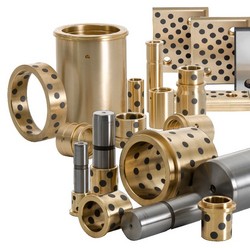Oct 19 2010
In manufacturing self-lubricating components for the tool and die industry, the SelfLube Company uses graphite as a solid lubricant.
Graphite, which has been used since ancient times, was always thought to be pretty well understood - until now. Recently, two scientists won the Nobel Prize for physics, for their research, which shows that graphite to be something of a super material.
 Some of SelfLube's components which use graphite/graphene as a solid lubricant
Some of SelfLube's components which use graphite/graphene as a solid lubricant
Graphite, a form of carbon, has always been a strange substance. It is one of the few materials that doesn't expand when heated or shrink when cooled (i.e., it has zero coefficient of linear expansion). It isn't a metal, but it conducts electricity like a metal. And, the strangest thing of all: in a universe that is essentially three dimensional, graphite forms a unique two-dimensional crystal (i.e., a crystal that is a sheet rather than a three dimensional shape). The graphite we are all familiar with, such as a pencil lead, is simply a pile of these crystal sheets. When you rub a pencil lead it feels oily. It's not. What you feel is the movement of these crystal sheets, which makes for the slipperiness.
These crystal sheets are very thin - only one atom thick. It would take a stack of 177 million or so of them to make an inch. No one was ever able to split off and examine a single sheet - until a pair of Nobel Prize winning scientists figured out how.
And, what they discovered was truly amazing. Graphene, the name given to a single sheet of graphite turns out to be the strongest material known - 100 times stronger than steel. It is not just a good conductor of electricity; it is the best-known conductor of electricity. And, it is slippery, very slippery.
Phil Allor, CEO of SelfLube, points out that "SelfLube has been ahead of the curve on this, using graphite/graphene and it's amazing properties as a super-lubricant for many years. There is no telling where this will lead us in the future."